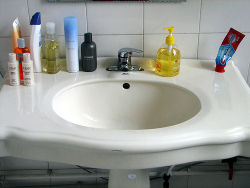
Okay, before I start, I’d like to say that I do shave my armpit hair, and wear antiperspirant when going to any public event. I don’t hang out under trees all day, though I do occasionally hug them.
Highly sensitive types like me process loud noises, strong fragrances, and uncomfortable fabrics differently than well … extra-resilient types. Everything we see, hear, smell, and touch affects our emotions. For that reason, I was fascinated by the new book, “The Healthy Home,” by Dr. Myron Wentz and Dave Wentz because it mentions every single toxin we come in contact with throughout the day – from our bedroom to the garage. Says Dave Wentz: “Every second of every day, we face an onslaught of unnecessary dangers–toxic chemicals, negative energies, unforeseen side effects, and more–in our modern world.”
I’m going to just focus on the skin right now since, upon turning 40, I’ve been seeking out the best miracle cream to undo all the damage, and am wondering if all the exfoliate, masque, and moisturizer are really poison getting into my bloodstream.
Here is what Dave Wentz says:
Given the vital roles it performs, protecting our skin is as important as watching what we eat and drink. My father [Myron Wentz] often says, “If you aren’t willing to eat something, you shouldn’t put it on your skin.” And he is correct. If we’re afraid to spray that antiperspirant on our tongue or squeeze a glob of that eye cream in our moth, we shouldn’t put it on our skin. After all, the same toxic chemicals we refuse to ingest are still entering our bodies and circulating to our cells.
A 2004 survey of 2,300 American men and women found that the average adult uses nine products–containing around 126 individual ingredients–every day.
Nine or more products every day? That’s a lot of fragrances, preservatives, and other chemicals coating the body’s largest organ.
We assume these products must be safe or else they wouldn’t be on store shelves. If your bathroom cabinet resembles most others, however, you have a chemical stockpile that should make your hair turn gray. Just read down the list of ingredients on your makeup removers, body washes, shaving foams, shampoos, conditioners, antiperspirants, moisturizers, lipsticks, foundations, powders, liquid liners, pencils, hair gels, mousses, sprays, toothpastes, rinses, whiteners, perfumes, nail polishes, sunscreens, spray-on tanners, bug sprays–even toilet paper, tampons, and bandages have chemicals added.
Do you ever wonder just how many chemicals are being absorbed through the skin and into the body when we use these items? You don’t have to wonder. A recent study found more than two hundred chemicals present just in the umbilical cord blood of newborns. Once our infants leave the relative safety of the womb, how many more sweet-smelling chemical compounds do we deliberately subject them to?
Keep in mind that personal-care products such as those listed above are typically only tested on adults. An estimated 10,500 different chemicals are used in cosmetics, skin-care treatments, and other personal products. Some of these chemicals are nitrosamines, lead and other heavy metals, parabens, phthalates, hydroquinone, and 1,4-dioxane–all very bad stuff.
Okay, now that I’ve painted the bleak and scary picture, what do we do if we’d like to stay clean and not smell too bad?
Beware of the following chemicals:
- Nitrosamines
- Lead acetate
- Mercury (thimerosal
- Diethanolamine (DEA)
- Synthetic color pigments
- Propylene glycol (PG)
- Coal tar
- Toluene
- Phenylenediamine (PPD)
- Petrolatum
- Parabens (methyl, propyl, butyl, and ehyl)
- Phthalates
- Hydroquinone
- 1,4-dioxane
- Quaternium 15
- 2-bromo-2-nitropropane-1,3-diol
- Diazolidinyl urea
- Imidazolidinyl urea
- DMDM Hydantoin
- Aluminum
Other than that, I just say wash your face with your hands. I heard that advice from a very wise man. My guess is that they aren’t toxic!
* Click here to subscribe to Beyond Blue and click here to follow Therese on Twitter and click here to join Group Beyond Blue, a depression support group. Now stop clicking.

